by Tom Gaylord
Writing as B.B. Pelletier
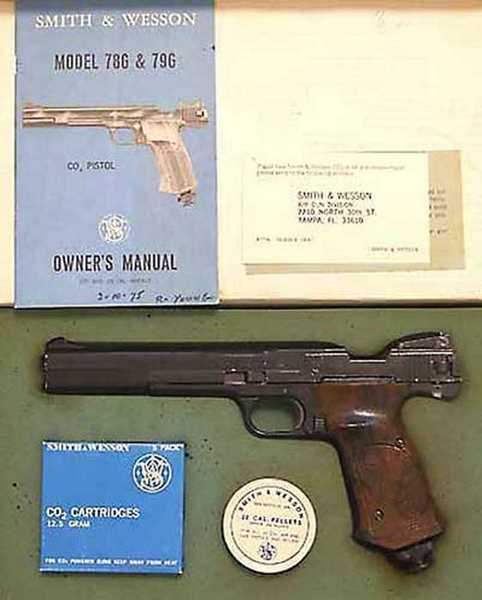
My S&W 78G pistol.
This report covers:
- Blog data helpful
- The test
- RWS Meisterkugeln
- Air Arms 16-grain dome
- Air Arms dome group 2
- Air Arms dome group 3
- Summary
Today we look at the accuracy of my S&W 78G pellet pistol. Normally this would be the final report in the series, but reader 45Bravo has given us a guest blog that shows the difference between the S&W pistols and the pistols made by Daisy, so there is at least one more installment coming.
Blog data helpful
I find the blog is a good place to make notes for the future, so today I looked over Part 2 to find out what sort of shot count I could count on. And also in Part 2 I showed you the manual that says to leave a CO2 cartridge in the gun for storage, so I knew there was a fresh CO2 cartridge inside, because last time I exhausted the gas at the end of the report. Today I can shoot at least 20 good shots from one cartridge.
The test
I shot targets at 10 meters. I rested the pistol on a sandbag, with the bottom of the pistol grip tight against the bag. That put the front sight as far from my eyes as I could get it. This pistol has wonderful target sights, so this test was shot under the best circumstances.
Since the pistol is a gas-guzzler I decided to shoot 5-shot groups. Let’s get started.
RWS Meisterkugeln
The first pellet I tried was the RWS Meisterkugeln. I had no idea where the sights were set except I knew I had shot the pistol in the past, so they were probably close to being on. They will change for every pellet, of course, so let’s see what happened this time.
The first shot hit high and right, but it was still inside the bull. Then I settled in and didn’t look at the target through the spotting scope again. When five pellets had been fired I went downrange to change the target. Then I saw the group — five pellets in 0.806-inches at 10 meters. Not terrible, but it’s an open group, so not that good, either. Time to move on to the next pellet.
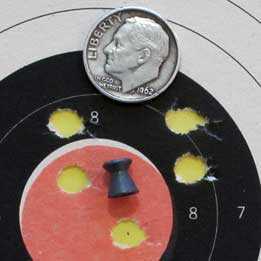
The S&W 78G put RWS Meisterkugeln in 0.806-inches at 10 meters.
Air Arms 16-grain dome
I thought a reader had recommended the Air Arms 16-grain dome pellet, so that was what I tried next. I can’t find where that recommendation was made, but sure enough, it is the pellet for this pistol! Five went into 0.468-inches at 10 meters, with 4 of them clustered in just 0.239-inches. I had other pellets to test, but when I saw this group I knew this was the one. So the rest of the test was shot with this pellet.
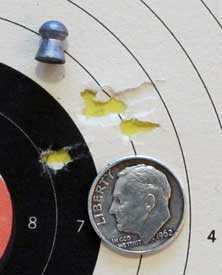
The 78G put 5 Air Arms 16-grain domes into 0.468-inches at 10 meters. Four of them are in 0.239-inches.
Since this pellet was so accurate, I decided to adjust the sights to get the group closer to the center of the bull. A former owner of the pistol had made a note inside the lid of the box on how to adjust the rear sight, so I followed that. It’s a lot better than the manual!
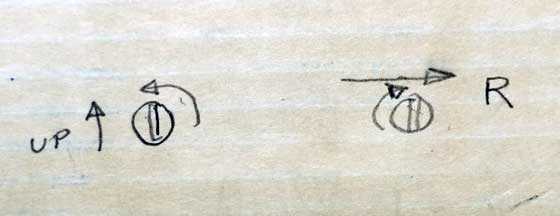
This might not look like much, but these directions for adjusting the rear sight came in handy. Yes, they are also in the manual, but hardly this clear!
Air Arms dome group 2
This time the group was larger and more open. It measures 0.938-inches between centers, but it confirms the sight adjustment was almost perfect. I just needed to try harder on my concentration next time. That, and a slight tweak to the left for the rear sight.
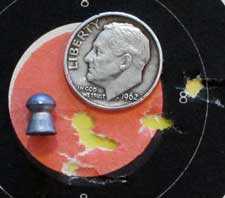
Though this group is more open and is actually the largest group of the test, it is reassuring. The sights are almost perfectly adjusted. Five pellets are in 0.938-inches at 10 meters.
Air Arms dome group 3
This one was almost a screamer. The pellets went close to the center of the bull, with 4 of them in 0.214-inches. One shot opened the group to 0.841-inches.
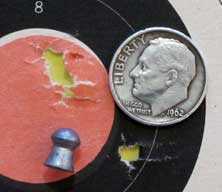
This is what I was hoping for. Five pellets are in 0.841-inches with 4 in 0.214-inches at 10 meters.
Summary
This S&W 78G can shoot! And I found a great pellet that proves it. This rebuilt gun has been modified for power so it uses gas quickly, but it also gets results downrange.
This isn’t the end. We still have a look at the Daisy pistols yet to come. Stay tuned.

B.B.
If those were 10 shot groups I would be impressed. But for 5 shot groups, not so much…
-Y
4 shots of that last group is a screamer for a .22 caliber 78G at 10 meters.
I haven’t tried that pellet yet in any of mine, I will have to give them a go.
I have been using RWS, H&N, and JSB in the .22’s.
The best pellet I have found so far for my Daisy 790 is the Benjamin Discovery pellets in 7.9gr. /product/benjamin-177-cal-7-9-grains-hollowpoint-750ct?p=1268
They give similar accuracy at 10 meters from a rest.
Over this last year, I have tried many others, but they are “the pellet” for this gun so far.
Just for my curiosity, where does your pistol fall in the production run? (serial number range)
Ian..
Ian,
It’s 47243.
B.B.
Thank you, I will add that info to my database, so to speak.
But since its been customized, it kind of nullifies it.
As grips may have been changed, we know the valve and bolt probe has been modified and possibly even had barrel barrel work done (recrown and lapped, or even replaced).
When the guns have not been tinkered with the serial numbers helps me figure out when they made certain changes to the production run.
I have to reverse engineer the series changes until I get the opportunity to TALK to someone that actually worked there, that built them.
I can say that by serial number 173X (I don’t own it so won’t publish it without their permission) unless the one I worked on was just a lucky one, the porous frame issue had been solved.
Things like this I am compiling, to one day make a guest blog so it will make it to a popular place on the internet so others can have access to it in the future.
We are all here to share information.
My dad told me once:
Everyone you meet knows something you don’t, learn from them.
45Bravo,
Is there a single way for the valve tp be meddled with or are there various ways to increase the flow of CO2?
Siraniko
There is always more than one way of doing something,
But the common ways seem to involve increasing the valve volume by some way.
Sometimes by reducing the size of the valve poppet, or removing some material from inside the valve body.
Also changing the valve spring/hammer spring combination to increase the time the valve stays open (called the dwell time).
And by increasing the size of the transfer port support the extra gas flow.
And of course polishing and smoothing out the path the gas has to flow to get to the pellet.
But you have a limited amount of barrel length for the extra gas to push the pellet faster.
If you go too far, you are just wasting gas with no benefit of velocity.
As of today, extra valve bodies and some limited parts are available at gunparts.com.
For those that want to tinker, and not mess with their factory valve.
Thank you very much 45Bravo.
Siraniko
Good morning everyone and B.B. alone, this is a comment specially addressed to you.
So what we have here is a .22 caliber, replica of a real pistol, shooting over 7 fpe accurately, made by a great firearm company. When will THEY decide to make these parameters basic? I would go for such airguns over bb shooting ones any day, accepting the 25-30 shot count. Since we’re talking about S&W, I dream of an N frame with the above mentioned parameters. And if I can go that far made by the same basic parts of the original. It gives me great joy every time I look at my Baikal MP654K, 1999 series, which still shoots smart shot at the 6fpe range…
Bill
Bill,
I think most serious shooters agree with you, but I don’t look for it to happen. I think those days have passed.
B.B.
Yea, not made in America, and not at this price point of $150 ish for a resealed 78G.
But it would be nice.
Umarex? Hint hint nudge nudge.
Ruger mark IV.
You are already making the replica 1022 for Ruger.
Make Its handgun counterpart.
A Single shot pellet replica target pistol.
That is actually capable of target accuracy.
Does anyone know if the Crosman Mk1 patent has expired yet?
Bill, the .22 is the tough nut in that list of characteristics when it comes to replicas. If replica isn’t a factor, then of course the 2240 comes to mind.
Michael
Michael as a matter of fact the 2240 set the bar for the parameters I mentioned. Short barrel and the internationally accepted 5fpe level. Imagine the same company’s 1858 replica with these features…
And one more thing for Crosman or Air Ventury to consider. The steel barrel and breach features in a single shot replica of a 1800 period pistol, preferably with a wooden grips option. Just like the M1 carbine options.
Whoever would not want such a piece of the U.S. history please raise hand.
Bill
Doesn’t have the fpe of the 2240, but there was (note past tense) the Crosman SA 6: /blog/2005/07/crosmans-single-action-six-another-blast-from-the-past/
Michael
Being a lefty, I love the 78/79 grips. They are very comfortable and ambidextrous.
The most accurate CO2 pistol I ever owned was an old Ted Williams model of the Crosman 150. Second was a S&W 78. I like the two power levels on a lot of CO2 pistols and rifles. I find the guns to be accurate and quiet on the low power setting plus getting more shots.
David Enoch
45 Bravo—-My 78G is serial # 0069545. It has the 2 power levels, a screw in the muzzle, below the barrel, and a small screw in the front of the trigger. It does not have a porous frame, ——–ED
Thank you.
That’s the highest serial number I have seen with the adjustable trigger.
Does it have light colored pale grips or the darker nicer grips?
The more info and numbers I can get the better I can fill in the gaps.
If you want to shoot me photos, my email is n5lyc@aol.com
S&W didn’t change too much after the trigger and power level changes.
Daisy on the other hand changed the way they branded their guns several times over their run.
As well as the major changes they made.
B.B.,
My impression is that shot count and velocity vary a lot among these vintage S&W CO2 pistols. Like the Crosman 600, Mark I and Mark II, they have often been resealed and have been hot-rodded at the same time. I have two 78Gs and one 79G. The 79G and one 78G seem stock, but the seller of the other 78G made clear to me that he personally had resealed it and hot-rodded it valve-wise. It is VERY powerful and a bit of a CO2 hog. It’s also much louder than my other 78G. I suspect David Enoch would not describe that one as being quiet. :^)
Michael
You have to remember, some of these guns and the Crosman MK1’s series are now between 45 & 53 years old.
The law of averages say someone has been into them at least once in its lifetime, and who knows what was done to it when they opened it.
Spring changes, sub par orings, maybe the gun was left cocked for decades while it was in a box, so the hammer spring is weak.
Not everyone who owned these, or the new owners who finds these are airgun people.
To them, an airgun, ANY airgun, is a toy.
I have refurbished one that was found in a drawer in a shed that was being demolished, it had very little finish left, and 4 pellets stuck in the barrel.
It looked like it had been a drawer with a bunch of screws and nuts that had acted like sand blasting media to remove the finish.
It went back to the new owner looking like new, and if he cares for it, it will be shooting for another 50 years, (urethane orings are the key).
Don’t cheap out when you reseal them unless you just like to go back in in a couple of years.
I love when someone sends me a gun that was found in their parents house, and they remember shooting it as a kid, and now they want to get it resealed so they can enjoy it with their kids.
The peoples stories are part of the fun.
Off topic,
Something interesting. Just found out the inner barrel on the Bushmaster and DPMS just happens to slide right into an airsoft barrel (6mm opening). May just be the particular airsoft barrel I had in hand from an extended barrel mock suppressor, and they do come in various tight bore dimensions, so I can’t say it will fit all right now.
But think of the possibilities it may present of shooting pellets through some of your favorite airsoft guns…. Even if it only turns out to be a single shot deal due to feeding situations.
I can only guess what the effect of a smaller bore would have on its velocity.
Bob M
Bob,
Interesting. You are always tearing into things and modifying them,… I like that! 😉
So,… assuming that you fit an airgun barrel inside of an airsoft barrel,… could you not use lead ball ammo instead of the plastic ball type? Or,… in the case of .177’s,… you have pellet/bb rifles that shoot both type of ammo. So the steel bb’s would also be spherical like the plastic ball. I suppose it comes down to the feed/magazine mechanism.
Chris
Chris USA
It’s not likely .177 steel bbs will remain captured at the top of an airsoft mag designed for a larger diameter ( 6mm ) plastic bb. Some may? But there are some airsoft revolvers that would be easy to convert with a barrel insert and simply using .177 ammo cartridges for say a Colt SAA. Most of those pistols are sold with airsoft or bb/pellet options anyway.
Converting an airsoft mag, or firing system to use steel bbs would be a real challenge and a lot of airsoft have actions that were designed specifically for a 6mm plastic bb. That’s why I mentioned that a single shot hand load may be the only option after a barrel change.
Would be fun to see if I could shoot pellets or bbs out of my airsoft replica bolt action CO2 powered CheyTac M200 Intervention or Barrett 50cal rifle for example. But projects are stacking up at home after our rainy season for now.
Bob M
Bob
Cool idea. If I had anymore airsoft guns I would try it.
And that barrel from the Bushmaster is pretty thin wall I guess. Won’t be much material from 6 mm to .177″.
45Bravo—-This 78 has been refurbished. It has a letter R on the butt, the metal has been painted a matt black. The grips look like they have been painted, sort of a Testors wood tan, or a Humbrol deck tan. The grips seem to be darker in between the checkering and where my thumb has worn away the paint. They may not be the original grips. ——Ed